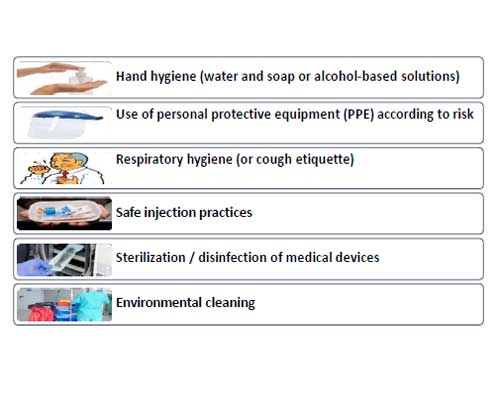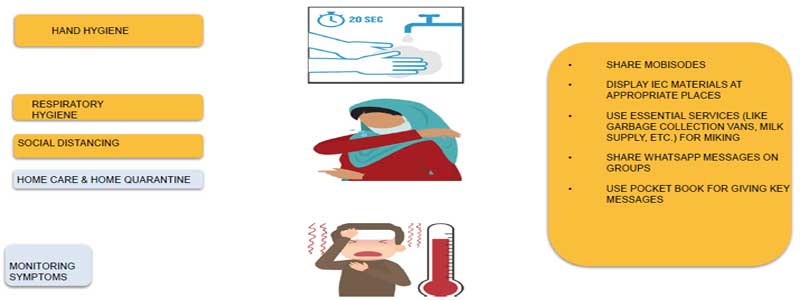Covid-19
Outline
- Overview of the natural history ofCOVID-19
- Standard precautions
- Transmission-based precautions
- Risk evaluation andPPE
- Gap assessment
- Requirements for the use ofPPE
Infection Prevention and Control and COVID-19

Overview of the natural history ofCOVID-19

Standard precautions

Today’s lecture . . .
Our focus will be on the use of personal protective equipment (PPE) according to the risk

Transmission-based precautions

As a reminder, transmission of COVID-19

Transmission-based precautions and COVID-19
| Scenario | Precaution |
|---|---|
| For any suspectedor confirmed case of COVID-19 | Standard + contact + dropletprecautions |
| For any suspected or confirmed case of COVID-19 andaerosol-generating procedure (AGP) | Standard + contact + airborneprecautions |
Risk evaluation and PPE

Risk evaluation and PPE

Risk evaluation and PPE

Some questions to consider.

Does the patient fulfill case definition criteria for the disease?

What is the infectious agent and it smode of transmission?

What type of procedure will the patient beundergoing?

Is there any riskof contamination?

Where should the patient belocated?

What type of PPEwill need to beused?
Gloves (sterile / non-sterile)
- Gloves are an essential item of PPE and are used to prevent the healthcare worker from being exposed to direct contact with the blood or body fluid of an infectedpatient.
- Gloves DO NOT replace hand hygiene.

Gowns (and aprons)
- Gowns are used in addition to gloves if there is risk of fluids or blood from the patient splashing onto the healthcare worker’s body.
- The same gown can be used when providing care to more than one patient but onlythose patients in a cohort area and only if the gown does not have direct contact with apatient.
- Plastic aprons should be used in addition to gowns if thematerial of the gown is not fluid repellent and the task to be performed may result in splashes onto the healthcare worker’sbody.

Facial mucosa protection (face shield, eye visor, goggles)
- Masks, and eye protection, such as eyewear and goggles, are also important pieces of PPE and are used to protect the eyes, nose or mouth mucosa of the health-care worker from any risk of contact with a patient’s respiratory secretions or splashes of blood, bodyfluids, secretions orexcretions.

Sequence for PPE

Putting on a PPE

Doffing a PPE

Medical masks (dropletprecaution)
- Wear a medical mask when within a 1 metre range of the patient.
- Put the patient in a singleroom or in a room that contains only other patients with the same diagnosis, or with similar risk factors, and ensure that every patient is separated by at least onemetre.
- Ensure that the transportation of a patient to areas outside of the designated room is kept toa minimum.
- Perform hand hygiene immediately after removingthe medicalmask.

Respirator [N95] (airborneprecaution)
- Use a respirator whenever entering and providing care within the patient isolation facilities ensuring that the seal of the respirator is checked before everyuse.
- Perform hand hygiene immediately after removing therespirator.
- Aerosol-generating procedures (AGP)…

Aerosol-generating procedures(AGP)
- Bronchoscopy
- Cardiopulmonaryresuscitation
- Noninvasive ventilation (BiPAP, CPAP,HFOV)
- Surgery
- Trachealintubation
- Manualventilation
- Sputuminduction
- Suctioning
- Laserplume
- Necropsy

Use of PPE according to level of care

Technical specifications,PPE

Technical specifications,PPE

RESPONSE AND CONTAINMENT MEASURES


RESPONSE AND CONTAINMENT MEASURES


Pretension is better than cure

Risk identification

Standard VS Enhance practices

Cleaning frequency table

In summary
- The use of personal protective equipment(PPE) by healthcare workers requires an evaluation of the risk related to healthcare-related activities;
-
The following precautions arere commended for thecare of patients with suspected or confirmed cases of COVID-19:
- For any suspected or confirmed cases ofCOVID-19
ostandard + contact + dropletprecautions - For any suspected or confirmed cases of COVID-19 and AGP
ostandard + contact + airborneprecautions
- For any suspected or confirmed cases ofCOVID-19

